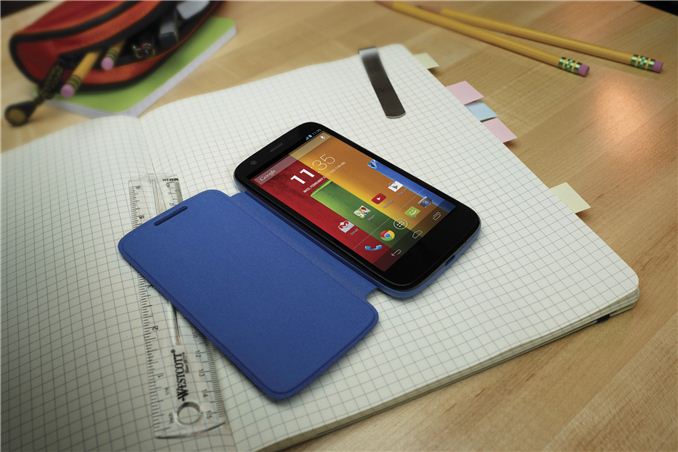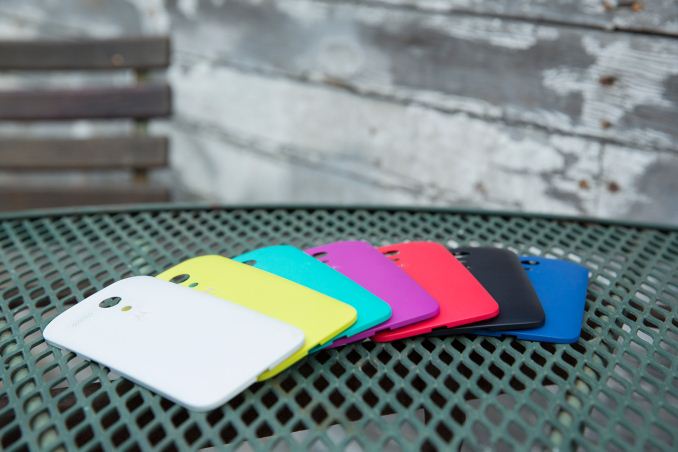Motorola's Affordable Moto G: $179 Off-Contract
by Anand Lal Shimpi & Brian Klug on November 13, 2013 10:23 AM EST- Posted in
- Smartphones
- Motorola
- Mobile
- Moto G

Earlier this morning Motorola announced the Moto G, the second member of its new smartphone lineup and a far more affordable alternative to the Moto X we reviewed back in August. The Moto G is available this week in Brazil and parts of Europe. Canada, Latin America, more of Europe and parts of Asia will get the device in the coming weeks. In the US we'll see the Moto G in early January. India, the Middle East and more of Asia will also get the Moto G in January. The big news here is the price: the Moto G will be available at $179 for an 8GB model or $199 for the 16GB model, unlocked and off-contract. The largest growth market for smartphones over the coming years is going to be at lower price points, so it makes complete sense that the Moto G would be the next release in the new Moto family.
To hit significantly lower price points than the Moto X, we see a number of changes. First and foremost is the adoption of Qualcomm's MSM8x26 SoC, branded as Snapdragon 400. The S400 implementation in the Moto G features four ARM Cortex A7 cores running at up to 1.2GHz and Qualcomm's Adreno 305 GPU. As Brian quickly pointed out after the announcement, Motorola is now in the unique position of shipping a quad-core SoC in its lower end phone and a dual-core SoC in its flagship. Obviously the other members of Motorola's X8 system (NLP & Contextual processors) are absent from the Moto G as well. In practice this means features like Motorola's active display and always on voice commands aren't present on the Moto G.
On the connectivity side, Moto G is listed as supporting GSM/GRPS/EDGE/UMTS/HSPA+ (21Mbps) or CDMA/EVDO Rev.A. There's no LTE support, at least on the version being launched today. Brian suspects that the US delay may be to move to Qualcomm's MSM8926 with integrated category 4 LTE modem, but we'll have to wait until January to find out.
With the Moto G we see a reduction in memory size from 2GB down to 1GB compared to the Moto X, as well as less NAND on-board (8/16GB vs. 16/32GB). Motorola also drops 802.11ac and 5GHz WiFi support. The front and rear facing cameras also see a downgrade compared to the Moto X, but that's to be expected as Motorola's 10MP clear pixel camera was quite costly to implement. The Moto G features a 4.5-inch 720p display, likely LCD based as there's no AMOLED requirement thanks to the absence of Motorola's Active Display.
The Moto G's chassis is clearly Moto X inspired, although slightly taller/wider and thicker. Customization is still a theme of the Moto lineup, but with the Moto G that customization comes through removable back covers. Motorola offers a total of 19 customization options: Motorola Shells that replace the back cover, Grip Shells that have a thicker, rubberized frame for better protection and Flip Shells that include a magnetic flip cover for the display.
| Moto G | Moto X | |
| SoC |
Qualcomm Snapdragon 400 (MSM8x26) 1.2GHz Quad-Core Cortex A7 + Adreno 305 |
Qualcomm Snapdragon S4 Pro (MSM8960Pro) 1.7 GHz Motorola X8 System (SoC+NLP Processor+Contextual Processor) |
| Display | 4.5-inch 1280x720 | 4.7-inch AMOLED (RGB) 1280x720 |
| RAM | 1GB | 2GB LPDDR2 |
| WiFi | 802.11b/g/n, BT 4.0 | 802.11a/b/g/n/ac, BT 4.0 |
| Storage | 8 GB/16 GB, 2 years 50 GB Google Drive | 16 GB standard, 32 GB online, 2 years 50 GB Google Drive |
| I/O | microUSB 2.0, 3.5mm headphone | microUSB 2.0, 3.5mm headphone, NFC, Miracast |
| OS at Launch | Android 4.3 | Android 4.2.2 |
| Battery | 2070 mAh | 2200 mAh, 3.8V, 8.36 Whr |
| Size / Mass | 65.9 x 129.9 x 6.0-11.6 mm, 143 grams | 65.3 x 129.3 x 5.6-10.4 mm, 130 grams |
| Camera |
5 MP Rear Facing 1.3 MP Front Facing |
10 MP Clear Pixel (RGBC) with 1.4µm pixels Rear Facing 2 MP 1080p Front Facing |
| Price | $179 (8 GB), $199 (16 GB) off-contract | $199 (16 GB), $249 (32 GB) on 2 year contract |
The Moto G will ship with a mostly stock version of Android 4.3, and Motorola is committing to an upgrade to KitKat in January 2014.

















50 Comments
View All Comments
mike8675309 - Wednesday, November 13, 2013 - link
The drop to 1gig of RAM is a real problem when the baseline for most phones today is 2gig. Living with today's Apps on a Droid X2 which only has 512MB of memory is painful. Say i have an pod cast playing while i'm tracking my run. Chances of one or the other getting clobbered by Android are extremely high. And it's getting worse. Now maybe Microsoft phone or Apple have better behaved memory management. But Android doesn't, and the O/S expects to be able to do things that sometimes doesn't have the memory to do. Then my phone reboots. My contract with Verizon can not end soon enough.Krysto - Wednesday, November 13, 2013 - link
You're forgetting it's getting KitKat soon, which should run well even on 512 MB. The flagship iPhone this year also has only 1 GB of RAM, and it uses 64-bit apps, so they use 30 percent more memory than usual.The RAM won't be the bottleneck. If anything, it's the CPU. But for the price, it's good enough.
Penti - Wednesday, November 13, 2013 - link
Will they make a serious international play here? It will at least be available in Europe now, but it was sad to see Motorola Mobility come back to the market just to fade out again when Google took over, you can't really buy a Motorola phone at the moment in Sweden, neither has there been much of products from them, they actually hasn't capitalized on tablets at all either, neither is any sold today. Mind you here Nexus 5 as sold through LG will cost ~635 dollars with sales tax, over 500 USD without, that's for the 349 dollar version. At least it's fun to see that it's more of a high-end device now, with LTE, 11 AC and NFC, and while they skimp out on the camera at least the pixel size has gone up. Screen is really on par with the competition now too. Their website kinda reminds me of Palm now, they have very little to show. There are certainly enterprise and consumer niches they could go after if they wanted to.At least it is fairly cheap, it's £135 in the UK, that would be about 220 USD for the 8GB. Now when it comes to tablet, there is really only the choice of Nexus 7 and iPads in my country. Samsung devices sell, but there is not a lot choice plus it's not like it would be hard to compete against low end HP, Lenovo, Asus and Acer devices.
For those complaining about MicroSD, it's an unlocked device (bootloader) check if there will be any custom roms that has mass storage support first as that's at least a way to add storage.
Penti - Wednesday, November 13, 2013 - link
When I say there isn't much tablet choice, I mean it btw. There is no Nook, Kindle (well they can ship them from the UK, but you don't really get access to much content or services) or Kobo. Just the ordinary Sony, LG, Huawei, Apple, Asus, Acer, Samsung etc bunch. Which basically mean Nexus 7 is the Android choice and there really isn't any competition in retail.snax001 - Thursday, November 14, 2013 - link
If they released an almost identical phone with a little more RAM and a top quartile camera (possibly a better CPU) for $75-$100 extra, not only would Google sweep up the budget market, I think they would grab a lot of middle to high cost sales in Europe. Aside from aesthetics, photo quality is one of the most visible differences between phones at the moment.Jon Tseng - Thursday, November 14, 2013 - link
>not only would Google sweep up the budget market, I think they would grab a lot of middle to>high cost sales in Europe.
Actually I suspect they wouldn't because $100 more and you start running into subsidised / contract phones in Europe. And in that case you are suddenly up against a $400 phone which is "free" on contract.
Where they are now is right at the sweet spot for unsubsidised PAYG. Actually it might be pushing the more expensive end of it - recall the Lumia 520 was £109 and sold like hotcakes and the Lumia 620 was £149 and didn't (smaller screen didn't help though, IMHO).
Penti - Thursday, November 14, 2013 - link
Well yeah, subsidized phones on contract typically cost the same no matter if they are 450 or 650 USD equivalent. That is part of the reason iPhone, Galaxy and other high-end devices are doing so well.As for payg, it's at least 135 - 160 GBP contract free in the UK, I'm elsewhere but that is surely above bargain payg-devices. It's often twice the amount. So it's not exactly a replacement for the Defy Mini.
It's at least something that can compete with previous generation stuff, but not more than so basically. It falls into the same price as HTC One V or Desire X, or Sony Xperia J and that class any how. Sure it's better than something like the Galaxy S3 mini too.
blzd - Tuesday, November 19, 2013 - link
Hard to believe people don't see the value in this $179/199 phone off contract and available at that price from carriers. This is like Nexus 5 value at a even smaller price point and personally I would be fine with the specs for this price. Looks great too.soullforged - Monday, December 2, 2013 - link
In Brazil, the Moto X costs significantly more than the Moto G...Wolfpup - Wednesday, December 4, 2013 - link
I'm curious about where this is made. I prefer iOS > Windows Phone > Android, but among android devices I'd consider this, Nvidia's devices, and the Nexus lines, and obviously being made in the U.S. would be a nice selling point.Specs seem okay, though I wonder how the A7 really performs. My understanding is even though it's smaller, it supposedly is within spitting distance of the A9, like it's much better than A8?
Oh well, at worst it's got to be one of the better phones for the price.